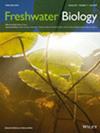Ephemeral Wetland Macroinvertebrate Communities Across Climate Regions Share Similar Functional Trait Composition Despite Near-Total Taxa Replacement
IF 2.7
2区 生物学
Q2 ECOLOGY
引用次数: 0
Abstract
- Community assembly in aquatic habitats is heavily influenced by hydrology, but understanding the influence of other habitat conditions is also critical. Most studies focus on comparisons of geographically close communities that exist under diverse hydrological regimes, but this framework limits our ability to understand how conditions other than hydrology shape ephemeral wetland communities. Here, we investigated how macroinvertebrate communities vary with local, landscape, and climate variables in ephemeral wetlands across a large geographic range with few geographic barriers.
- We sampled ephemeral wetlands in North Dakota, New Mexico, and Texas (USA) in 2021 and in North Dakota and New Mexico in 2022. We used an array of hydrographic, climate, landscape, and spatial variables to relate taxonomic and functional macroinvertebrate community composition and diversity to habitat conditions.
- Taxonomic composition was overwhelmingly different among states and between years: landscape-scale refuge availability explained variation in taxonomic composition, but local and climate-scale variables only explained variation within the context of other variables. Trait composition was similar between most sampling groups, but distinct trait assemblages occurred in the North Dakota 2021 communities. No predictor variable matrix explained trait composition alone, but local, climate, landscape, and spatial arrangement predicted composition when considering the overlapping influence of other variables. Taxa and trait diversity indices were associated with increased refuge habitat at landscape scale.
- Our results show consistent trait structure across a large geographical scale in hydrologically similar wetlands, despite almost complete taxonomic turnover between regions. Patterns in taxonomic and functional composition imply that incorporating predictor variables at multiple scales is critical in understanding ephemeral wetland community composition.
- Despite similar hydrological regimes and potential for connectivity via dispersal, taxa replacement is high in ephemeral wetlands across regions within a single grassland macrosystem. Taxonomic composition and overall diversity change with the context provided by a diverse suite of structuring variables. Further, we show that in most cases, ephemeral hydrology elicits a similar trait response across climate regions.
不同气候区域的湿地大型无脊椎动物群落在类群几乎完全替换的情况下具有相似的功能性状组成
水生生境的群落聚集受到水文的严重影响,但了解其他生境条件的影响也至关重要。大多数研究都集中在不同水文制度下存在的地理上接近的群落的比较上,但这种框架限制了我们理解水文以外的条件如何塑造短暂的湿地群落的能力。在这里,我们研究了大型无脊椎动物群落是如何随着当地、景观和气候变量的变化而变化的,在一个大的地理范围内,几乎没有地理障碍。我们于2021年在北达科他州、新墨西哥州和德克萨斯州(美国)取样,并于2022年在北达科他州和新墨西哥州取样。我们利用一系列水文、气候、景观和空间变量,将大型无脊椎动物群落的分类和功能组成和多样性与栖息地条件联系起来。分类学组成在不同的州和年份之间有着压倒性的差异:景观尺度的避难所可用性解释了分类学组成的变化,但当地和气候尺度的变量只能解释其他变量背景下的变化。大多数取样组之间的性状组成相似,但在北达科他州2021群落中出现了明显的性状组合。没有预测变量矩阵单独解释性状组成,但考虑到其他变量的重叠影响,局部、气候、景观和空间排列可以预测组成。在景观尺度上,类群和性状多样性指数与避难生境的增加有关。我们的研究结果表明,在水文相似的湿地中,尽管区域之间几乎完全完成了分类转换,但在大地理尺度上具有一致的特征结构。分类和功能组成模式表明,在多个尺度上纳入预测变量对于理解湿地群落的短暂性组成至关重要。尽管有相似的水文条件和通过分散而实现连通性的潜力,但在单一草原大系统内的各个地区,短期湿地的分类群替换率很高。分类组成和总体多样性随不同结构变量提供的上下文而变化。此外,我们表明,在大多数情况下,短暂的水文引发了跨气候区域的类似特征响应。
本文章由计算机程序翻译,如有差异,请以英文原文为准。
求助全文
约1分钟内获得全文
求助全文
来源期刊

Freshwater Biology
生物-海洋与淡水生物学
CiteScore
5.90
自引率
3.70%
发文量
162
审稿时长
2 months
期刊介绍:
Freshwater Biology publishes papers on all aspects of the ecology of inland waters, including rivers and lakes, ground waters, flood plains and other freshwater wetlands. We include studies of micro-organisms, algae, macrophytes, invertebrates, fish and other vertebrates, as well as those concerning whole systems and related physical and chemical aspects of the environment, provided that they have clear biological relevance.
Studies may focus at any level in the ecological hierarchy from physiological ecology and animal behaviour, through population dynamics and evolutionary genetics, to community interactions, biogeography and ecosystem functioning. They may also be at any scale: from microhabitat to landscape, and continental to global. Preference is given to research, whether meta-analytical, experimental, theoretical or descriptive, highlighting causal (ecological) mechanisms from which clearly stated hypotheses are derived. Manuscripts with an experimental or conceptual flavour are particularly welcome, as are those or which integrate laboratory and field work, and studies from less well researched areas of the world. Priority is given to submissions that are likely to interest a wide range of readers.
We encourage submission of papers well grounded in ecological theory that deal with issues related to the conservation and management of inland waters. Papers interpreting fundamental research in a way that makes clear its applied, strategic or socio-economic relevance are also welcome.
Review articles (FRESHWATER BIOLOGY REVIEWS) and discussion papers (OPINION) are also invited: these enable authors to publish high-quality material outside the constraints of standard research papers.
 求助内容:
求助内容: 应助结果提醒方式:
应助结果提醒方式:


